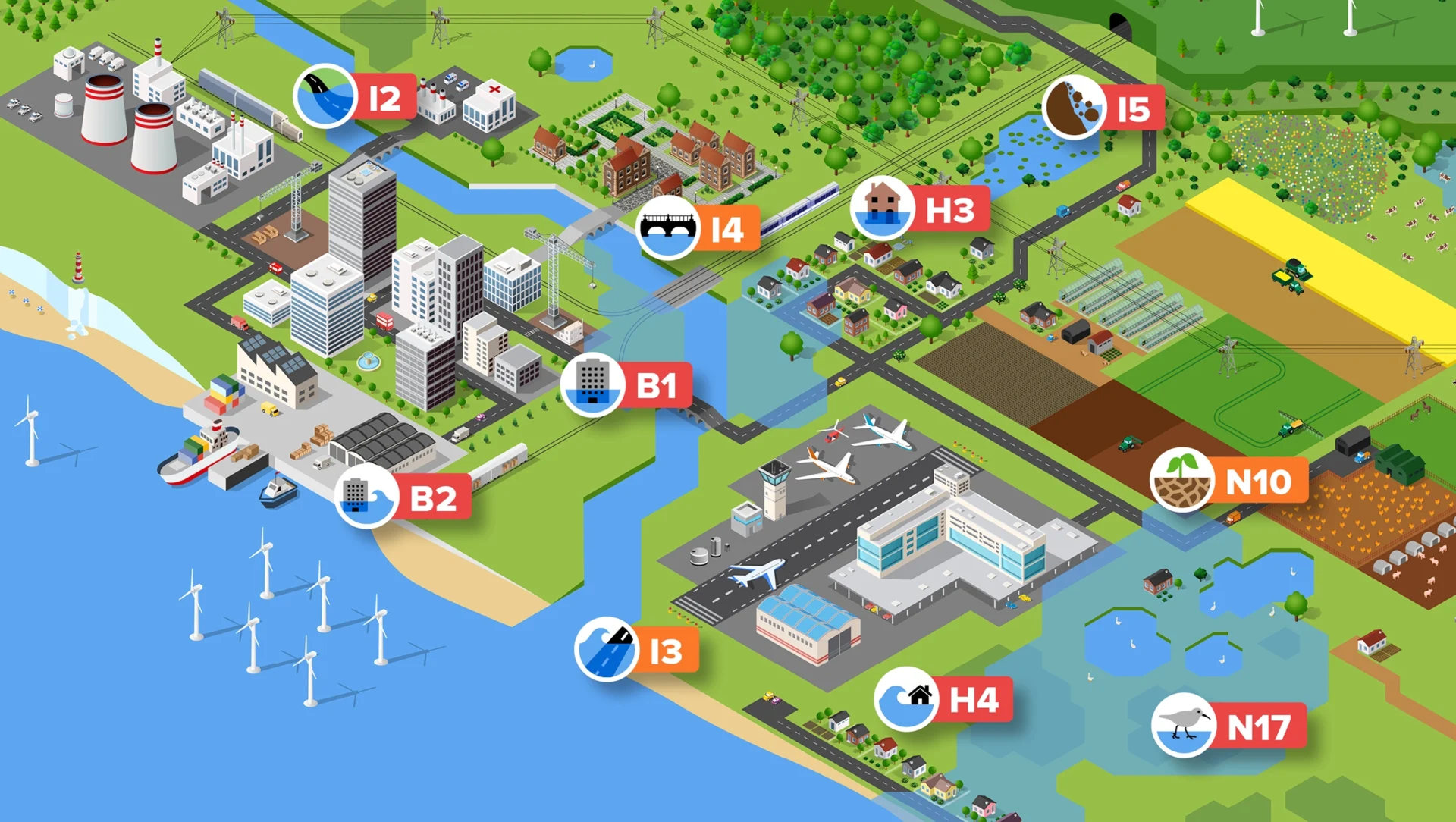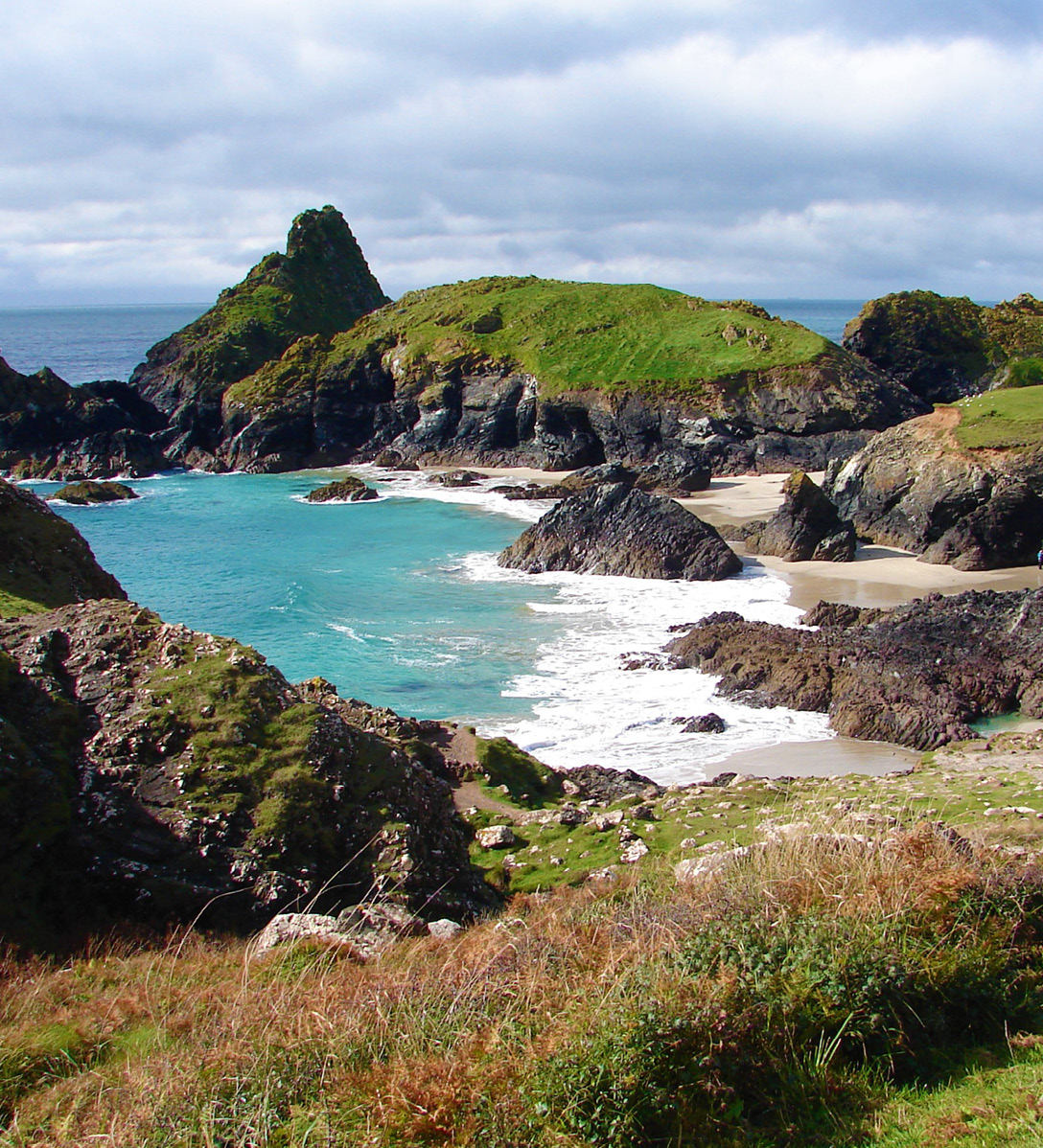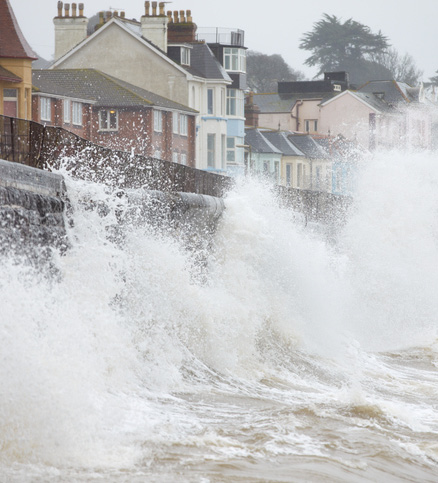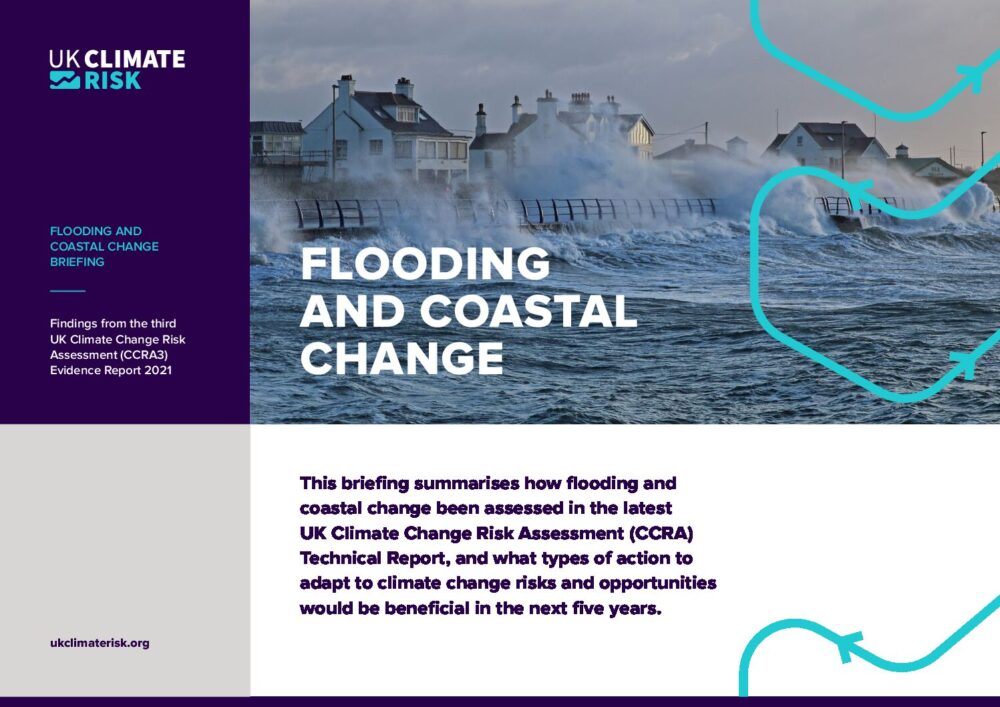Flooding and Coastal Change Briefing
About this document
Findings from the third UK Climate Change Risk Assessment (CCRA3) Evidence Report 2021
This briefing summarises how flooding and coastal change been assessed in the latest UK Climate Change Risk Assessment (CCRA) Technical Report, and what types of action to adapt to climate change risks and opportunities would be beneficial in the next five years.

This publication is available in PDF format at the end of the page >
The full assessment looks at risks and opportunities for the UK under two climate change scenarios, corresponding to approximately a 2°C or a 4°C rise in global temperature by 2100. It answers three questions, for 61 different risks or opportunities using available published evidence and analysis:
- What is the current and future level of risk or opportunity?
- Is the risk or opportunity being managed, taking account of government action and other adaptation?
- Are there benefits of further adaptation action in the next five years, over and above what is already planned?
The main findings from the full assessment related to flooding and coastal change are summarised below, together with the adaptation actions that would be beneficial over the next five years.
Each risk or opportunity has an identifier code linked to the full analysis, which is available in the CCRA3 Technical Report. Readers are encouraged to use these briefings to locate the parts of the Technical Report of most relevance to them.
Alternatively, if you would like a summary of the analysis by UK nation, please go to the national summary documents:
This briefing is aimed primarily at the UK Government, the governments of Scotland and Wales, the Northern Ireland Assembly and their respective departments and agencies responsible for agriculture and food. However, it should also be of interest to a wider audience.
Key messages
- Climate change will increase sea levels and associated coastal flooding and erosion, as well as altering rainfall patterns leading to changes in river, surface water and groundwater flooding.
- Current projections for the UK show the likely change in sea level to be between 0.27 and 1.12 metres by the end of the century. The assessment agrees with other evidence suggesting that the UK will almost certainly have to adapt to over 1 metre of sea level rise in the future, though the full extent of sea level rise will not necessarily occur before 2100.
- The current percentage of coastlines vulnerable to erosion across the UK are 28% in England and Wales, 19.5% in Northern Ireland and 19% in Scotland. Changes in future erosion rates due to climate change have not been estimated across the whole of the UK.
- Flooding poses a significant risk to people, communities and the built environment with approximately 1.9 million people across the UK currently living in areas at significant risk from either river, coastal or surface water flooding. The number of people at risk could double as early as the 2050s.
- Continued investment in a range of integrated actions to reduce flood impacts for people, communities and the built environment will have large net benefits, and significant new policies have been announced across the UK since CCRA2 was published in 2017.
- Infrastructure services such as transport are increasingly at risk from river, surface water and groundwater flooding, and despite progress in installing flood defences, these alone will not keep the risk from flooding at today’s level into the future and will require further government intervention.
- Flooding and coastal change also impacts businesses across the UK, with average damages of £120 million per year to business premises from coastal flooding alone. SMEs are particularly vulnerable to impacts as they have less capacity to respond than large businesses.
- Aquifers located near the coast could also be at greater risk from saltwater intrusion due to sea level rise, though the assessment suggests this risk is being managed.
Risks, opportunities, and benefits of further action

Average UK wide scores

N10. Risks to aquifers and agricultural land from sea level rise, saltwater intrusion
Further investigation

N17. Risks and opportunities to coastal species and habitats
More action needed

I2. Risks to infrastructure services from river, surface water and groundwater flooding
More action needed

I3. Risks to infrastructure services from coastal flooding and erosion
Further investigation

I4. Risks to bridges and pipelines from flooding and erosion
Further investigation

I5. Risks to transport networks from slope and embankment failure
More action needed

H3. Risks to people, communities and buildings from flooding
More action needed

H4. Risks to the viability of coastal communities from sea level rise
More action needed

B1. Risks to business sites from flooding
More action needed

B2. Risks to business locations and infrastructure from coastal change
More action needed
1. Risks to aquifers and agricultural land from saltwater intrusion (N10)
If sea levels rise relative to fresh groundwater levels, saltwater can enter the aquifer and increase salinity in agricultural land. Saltwater cannot be used to irrigate crops or be consumed by people.
The risk is currently low at present and most likely to remain low in future unless a much greater rate of sea level rise was to occur than most estimates expect (the likely range for the UK being between 0.27 and 1.12 metres by 2100).
Current risk management procedures should remain adequate to adapt to the risk subject to further review. However, it is noted that the risk in south-east England may be greater than the rest of the UK, partly because of the combination of saline intrusion and expected reduced summer rainfall, where some aquifers provide public water supplies, for example in Dungeness in Kent.

Beneficial actions in the next five years include:
- Further research on changes in exposure and vulnerability, including in the context of the latest scientific data on sea-level rise.
- This could occur alongside further investigation into the operational use of adaptation pathways related to changes in sea level rise, precipitation patterns and safe abstraction rates.
- Better storage and use of excess winter rainfall and other methods to maximise sustainable use of surface water resources (e.g. rainwater harvesting and on-farm reservoirs) to conserve groundwater resources at a sustainable level and mitigate against saline intrusion.
- Continue monitoring the impact on aquifers to assess whether risks are increasing.
Further details on this risk: Natural Environment and Assets Technical Chapter, risk N10
2. Risks and opportunities to coastal species and habitats due to coastal flooding, erosion, and climate factors (N17)
Coastal habitats occur at the boundary of terrestrial and marine environments and include saltmarsh, machair, shingle, sand dunes and sea cliffs.
These environments provide ecosystem services such as flood and erosion protection, climate regulation and tourism opportunities, which were valued to be worth at least £48 billion in the UK in 2007.
The percentage of coastlines vulnerable to erosion across the UK are 28% in England and Wales, 19.5% in Northern Ireland and 19% in Scotland.
The current magnitude of risk/opportunity is medium rising to high by the 2050s for all four nations due to the predicted magnitude of sea level rise.

Beneficial actions in the next five years include:
- Adaptation through effective implementation of nature-based solutions, including managed realignment and habitat restoration, to reduce risks and provide multiple benefits.
- Adaptation strategies should be designed to be more flexible and robust against the wider range of climate change projections, especially for higher rates and magnitudes of sea level rise.
- At national level, a thorough review of current governance and delivery to promote a more strategic, long-term approach to managing the long-term effects of coastal change on the UK coastline.
- Increased financial support for Coastal Observatories around the UK to help coordinate research on long-term coastal change.
Further details on this risk and opportunity: Natural Environment and Assets Technical Chapter, risk/opportunity N17
3. Risks to infrastructure services from river and surface water flooding (I2)
River and surface flooding is already a large risk to UK infrastructure, with each flooding episode adding new evidence to underpin the significant magnitude of the threat.
Currently, all infrastructure services are at a greater exposure to surface water flooding than river flooding, with detailed numbers for each UK nation available in the Infrastructure Technical Chapter.
All infrastructure assets across the four nations will face increased exposure to surface water risk in the absence of further adaptation action. In some scenarios, a potential doubling of risk in a 4°C warming scenario is projected by the 2080s in a low population growth scenario.
The magnitude of risk is classified as high both now and in future for all four nations.

Beneficial actions in the next five years include:
- Develop consistent indicators of network resilience to flood risk across all critical national infrastructure sectors and networks to help to create the right institutional conditions for adaptation in the next five years and in the long-term.
- Utilise both green (nature-based) infrastructure and conventional engineering measures to improve resilience to the risks of flooding, for example by implementing more green sustainable drainage solutions (SuDS).
- Bring forward adaptation works, for example in the protection of electricity substations. It is estimated that if National Grid brought forward the entirety of planned works scheduled for 2022 this would result in additional savings of £133 million in avoided annual losses.
Further details on this risk: Infrastructure Technical Chapter, risk I2
4. Risks to infrastructure services from coastal flooding and erosion (I3)
Sea levels are currently rising and the rate of rise is accelerating, including around the UK. Coastal flood and erosion risk to infrastructure services, including those associated with the energy sector, will therefore grow.
The consequences of coastal flooding have been tempered over time due to improvements in flood defences, together with advances in flood forecasting, warning and emergency response and spatial planning. Despite this, notable coastal flooding incidents have still occurred that have significantly impacted infrastructure, and assets remain located in low lying coastal areas which will be threatened in the event of a defence failure.
In total, 35 power stations, 22 clean water facilities and 91 sewage treatment works across the UK have been identified as being located in areas at significant risk from coastal flooding. The entire nuclear fleet of power stations is also located in the coastal zone, but they are very well protected. The risks to transport infrastructure located at the coast (rail lines and roads) are likely to be more significant as they are not as easy to protect along their entire length.
The risk will increase as sea level continues to rise, but the magnitude remains medium in the future according to the evidence available.

Beneficial actions in the next five years include:
- The use of adaptation pathways for the long-term planning of flood risk management, first used in developing the Thames Estuary 2100 flood risk management strategy, has been shown to be a promising technique that can be applied more widely in the UK.
- Given the uncertainties around sea level rise, ‘what if’ planning for high coastal risk scenarios can help with understanding what could be done in the event of very high rates of change.
Further details on this risk: Infrastructure Technical Chapter, risk I3
5. Risks to bridges and pipelines from flooding and erosion (I4)
Flooding, erosion or scour (the eroding of soil around foundations, including bridges) due to increased rainfall can lead to travel disruption, significant repair costs and the potential isolation of remote communities.
Bridges also have significant potential for lock-in of climate risks due to their long service lives (often exceeding 100 years), and high cost of retrofitting, making them priority assets for adaptation. Increased winter precipitation and higher river flows will increase scour, potentially increasing the rate of failure of bridges in the UK. Flooding causes knock on impacts at bridges and pipelines such as the ability of engineers to access and repair assets.
Examples of recent impacts include the aftermath of Storm Desmond, where Cumbria County Council had to spend around £120 million on repairs to over 270 bridges. Another well-known example was the collapse of the Tadcaster bridge due to flooding in 2015, which also ruptured the gas pipelines that spanned the bridge.
Currently, there are no quantitative assessments of climate change impacts from flooding or erosion on pipelines. The magnitude of risk is classified as medium now and in future for all four nations, and confidence in the assessment is low.

Beneficial actions in the next five years include:
- Produce future estimates of the risks to bridges and pipelines from flooding and high temperatures. Modifications can be made to bridges to reduce their vulnerability to damage from flooding, including any other infrastructure they carry such as cables and pipelines.
- For pipelines, improve drainage in areas that regularly flood, monitoring of river and coastal erosion, and the development of flood, coastal and updated contingency defence measures.
- Ongoing monitoring and maintenance of both types of assets will remain crucial to spot problems in enough time to act.
Further details on this risk: Infrastructure Technical Chapter, risk I4
6. Risks to transport networks from slope and embankment failure (I5)
There are around 20,000km of slopes and embankments supporting the UK’s transport infrastructure. Deterioration and failure of these assets, which are often associated with heavy rainfall and flood events, have significant negative impacts on transport networks through damage, travel delays and accidents.
A tragic recent example from 2020 was near Stonehaven, where a passenger train hit a landslip following heavy rain and derailed, killing three people. It is also known that older, less well compacted assets such as those supporting the rail network are deteriorating at a faster rate than newer assets built to more modern standards.
Between 2003 and 2014 there were, on average, 67 earthwork failures a year across the rail network in Scotland, England and Wales. Increases in high rainfall and soil moisture fluctuations combined with periods of dry weather and subsequent cracking are expected to lead to an increase in failures in the future. There are implications for more rural areas of the UK, where transport infrastructure systems are less resilient, and often follow natural features such as steep-sided river valleys prone to landslides. Slope failures in coal tips is also a specific risk for Wales that is included in the analysis.
The current and future magnitude of risk is medium for all four nations. The cost of adaptation measures across rail and road networks is usually offset by reduced repair costs and travel delays.

Beneficial actions in the next five years include:
- Factor in updated projected increases in heavy rainfall events to long-term renewal programmes, especially for the rail network.
- Improve numerical tools, instrumentation and monitoring systems such as forecasting and warning systems to increase understanding of slope failure processes in relation to weather and climate, as well as using more detailed characterisation of assets to better understand the spatial distribution of risk.
- Continue to use slope inspection programs and employ greater use of soft engineering techniques, such as vegetation management, to reinforce vulnerable slopes.
- Enhance maintenance of drainage systems for roads and railways and increased drainage capacity in new road infrastructure.
Further details on this risk: Infrastructure Technical Chapter, risk I5
7. Risks to people, communities and buildings from flooding (H3)
The risk of flooding to people, communities and buildings is one of the most severe climate hazards for the population, both now and in the future.
Approximately 1.9 million people across the UK are currently living in areas at significant risk from either river, coastal or surface water flooding. This number could double as early as the 2050s.
Flooding has profound impacts on the people who experience it. As well as a small number of annual deaths or injuries, there is growing evidence of long-term and severe impacts on mental health and wellbeing from flooding; damage to property including the upheaval and financial implications of cleaning up; disrupted access to employment, education, health services and wider facilities; and illness from water-borne pathogens or chemical contaminants arising from floods.
The magnitude of risk is classified as high now and in future for all four nations.

Beneficial actions in the next five years include:
- Working across the UK nations and widely sharing outcomes from case study examples and initiatives, such as the Flood and Coastal Resilience Innovation programme in England, to enable a more integrated approach and more fuller public engagement.
- Increase investment in socially vulnerable areas and introduce new metrics focused on reducing social vulnerability to flooding to help further mitigate the social costs of flooding.
- Understand how new developments built in at-risk areas are being made safe and resilient, for all new properties in high risk locations. This information should be publicly available by development, and should include whether properties are being protected by flood defences and property flood resilience.
- There is a strong argument for greater enforcement on SuDS, which will help to reduce flood risk but also help to achieve biodiversity net gain in new developments.
Further details on this risk: Health, Communities and Built Environment Technical Chapter, risk H3
8. Risks to the viability of coastal communities from sea level rise (H4)
This risk is focused on coastal change which is physical change to the shoreline caused by coastal erosion, coastal landslip, permanent inundation or coastal accretion that is of such severity that the long-term sustainability and viability of coastal communities is threatened.
A summary of the associated risks is as follows:
- Parts of the south and east coasts of England and the west coast of Wales already face risks to their viability because of coastal erosion. Existing evidence does not indicate any coastal communities in Northern Ireland or Scotland have current risks to their viability.
- Current risks from erosion to UK properties or households are 8,900 (England), 2,720 (Northern Ireland), 212 (Scotland), and 400 (Wales).
- Future projections of coastal erosion are only currently available for England, suggesting up to 82,000 properties could be at risk by the end of the century.
- There are also no UK-wide projections of risk to the viability of coastal communities, either from erosion or catastrophic flooding.
- The magnitude of the risk to coastal community viability is currently considered low, but rises to high for England and Wales, and medium for Scotland and Northern Ireland by the end of the century.

Beneficial actions in the next five years include:
- Driving coastal flood and erosion management through integrated engineering, planning, insurance and preparedness activities, including consideration of where managed retreat (relocation away from the coast) might be necessary.
- Continuing the increasing emphasis on community or individual led activities to increase resilience.
- Further advances in mapping and modelling.
- Engaging local communities that have been identified as at risk, including through the provision of clear messages about how change will be delivered where this is needed. This could bring in requirements in relation to the areas of national strategic planning, providing a legal adaptation planning framework, local delivery and funding, further community engagement, awareness raising and buy-in from community leaders.
- The CCRA technical chapters focus on the case study of the village of Fairbourne, where this process of transition to managed retreat is already underway.
Further details on this risk: Health, Communities and Built Environment Technical Chapter, risk H4
9. Risks to businesses from flooding (B1)
Current and future risks to business sites and functions from flooding are significant, with high magnitude impacts expected across the UK.
Present day expected annual damages to non-residential properties across the UK average around £670 million. Damages could increase in a 2°C warming scenario by around 27% by 2050 and 40% by 2080, and in a 4°C scenario by around 44% by 2050 and 75% by 2080. These projections assume no changes in the asset base or size of the economy.
Costs to businesses arise from damage to sites as well as from business interruption and indirect losses, such as lost production time and associated costs. Flood risk management actions being taken forward, including flood protection and planning and preparedness through business continuity management, is encouraging but given the scale and the wider implications for the economy and society at large, more action would be beneficial.
The availability of insurance and costs of capital could increase the magnitude even further unless risk levels are reduced through corporate as well as community-level adaptation action.

Beneficial actions in the next five years include:
- Actions to improve the evidence base and provide advice and support to businesses.
- Increasing the investment in adaptation through a much higher uptake of property-level protection, raising awareness of flood warnings, greater use of SuDS and continued investment in flood defences could decrease expected annual damages for non-residential properties from today’s level by 5% by 2050 and limit damage to an increase of 1% by 2080 compared to present day levels of expected damages under a 2°C global temperature rise scenario. In a 4°C scenario, impacts still rise even with very high levels of adaptation.
Further details on this risk: Business Technical Chapter, risk B1
10. Risks to businesses and infrastructure from coastal change from erosion, flooding, and extreme weather events (B2)
A considerable amount of industrial and commercial activity and infrastructure exists along the coast for most of the UK.
The geomorphology of the coastline, coastal processes, nature of the hazard, past human intervention in the coast and coastal protection policies will all determine how coastal risks to businesses change in the future.
Flooding and coastal change is a medium magnitude risk to businesses in England and Scotland and a high magnitude risk to businesses in Wales and Northern Ireland now (with average damages of £120 million per year to business premises from coastal flooding alone) and is expected to become a high risk by the 2050s for all UK countries.
Without further adaptation, damages could increase by around 30% by 2050 and 75% by 2080 under a 2°C scenario. In a 4°C scenario the damages could rise by around 80% by 2050 and 180% by 2080.

Beneficial actions in the next five years include:
- Enable businesses to become involved in coastal protection and change projects, through partnership funding of coastal redevelopment, habitat creation or new methods of construction to better protect properties.
- Better provision of information from national and local government about protection levels and the limits of flood defences for coastal businesses, along with linking the future risks from climate change to coastal management strategies and development of visions by coastal communities.
- Investments in community resilience and inclusive community engagement, along with research into business opportunities in high-risk coastal locations.
Further details on this risk: Business Technical Chapter, risk B2
Variations across the UK
| Risk/Opportunity | England | Northern Ireland | Scotland | Wales |
| N10. Risks to aquifers and agricultural land from sea level rise, saltwater intrusion | Further Investigation | Watching Brief | Watching Brief | Further Investigation |
| N17. Risks and opportunities to coastal species and habitats | More Action Needed | More Action Needed | More Action Needed | More Action Needed |
| I2. Risks to infrastructure services from river, surface water and groundwater flooding | More Action Needed | More Action Needed | More Action Needed | More Action Needed |
| I3. Risks to infrastructure services from coastal flooding and erosion | Further investigation | Further investigation | Further investigation | Further investigation |
| I4. Risks to bridges and pipelines from flooding and erosion | Further Investigation | Further Investigation | Further Investigation | Further Investigation |
| I5. Risks to transport networks from slope and embankment failure | More Action Needed | More Action Needed | More Action Needed | More Action Needed |
| H3. Risks to people, communities and buildings from flooding | More Action Needed | More Action Needed | More Action Needed | More Action Needed |
| H4. Risks to the viability of coastal communities from sea level rise | More Action Needed | Further Investigation | More Action Needed | More Action Needed |
| B1. Risks to business sites from flooding | More Action Needed | More Action Needed | More Action Needed | More Action Needed |
| B2. Risks to business locations and infrastructure from coastal change | More Action Needed | More Action Needed | More Action Needed | More Action Needed |
Background
The UK Government is required by the UK Climate Change Act 2008 to assess the risks and opportunities from climate change to the UK every five years and respond to the risks via a National Adaptation Programme, covering England. The devolved administrations also publish their own adaptation programmes in response to the risk assessment.
For this third UK Climate Change Risk Assessment, the Government’s independent advisers on climate change, the Climate Change Committee (CCC), have been asked to prepare an independent risk assessment setting out the latest evidence on the risks and opportunities to the UK.
Over 450 people from more than 130 organisations have contributed to preparing the assessment. The risks have been assessed using the latest climate projections for the UK which were updated in 2018 by the Met Office. These briefings summarise some of the key topics that are assessed through the Technical Report, to enable readers to understand the key messages and where to find more detail.
Where to find more detail
Each risk or opportunity in this briefing has an identifier code linked to the full analysis, which is available in the CCRA3 Technical Report. Readers are encouraged to use these briefings to locate the parts of the Technical Report of most relevance to them.
Alternatively, if you would like a summary of the analysis by UK nation, please go to the national summary documents:
Share on:

